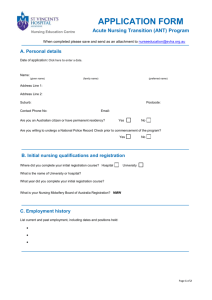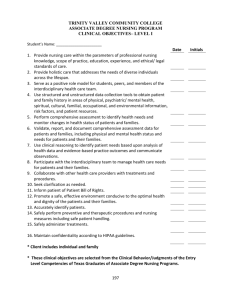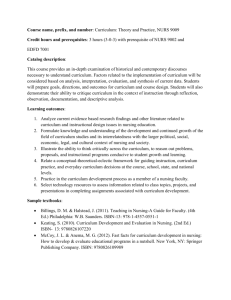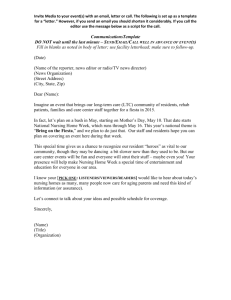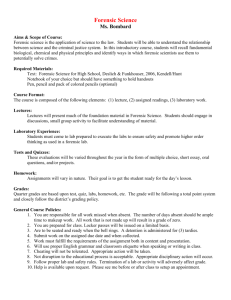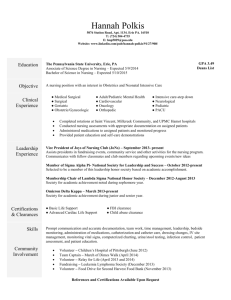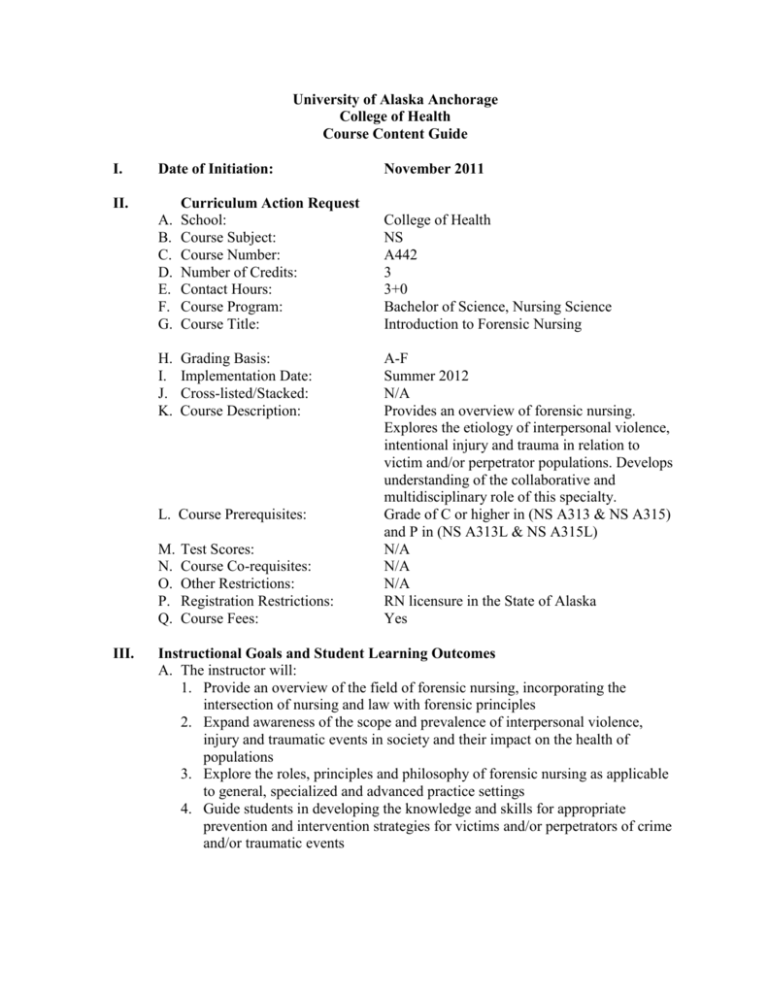
University of Alaska Anchorage
College of Health
Course Content Guide
I.
Date of Initiation:
II.
A.
B.
C.
D.
E.
F.
G.
Curriculum Action Request
School:
Course Subject:
Course Number:
Number of Credits:
Contact Hours:
Course Program:
Course Title:
H.
I.
J.
K.
Grading Basis:
Implementation Date:
Cross-listed/Stacked:
Course Description:
L. Course Prerequisites:
M.
N.
O.
P.
Q.
III.
Test Scores:
Course Co-requisites:
Other Restrictions:
Registration Restrictions:
Course Fees:
November 2011
College of Health
NS
A442
3
3+0
Bachelor of Science, Nursing Science
Introduction to Forensic Nursing
A-F
Summer 2012
N/A
Provides an overview of forensic nursing.
Explores the etiology of interpersonal violence,
intentional injury and trauma in relation to
victim and/or perpetrator populations. Develops
understanding of the collaborative and
multidisciplinary role of this specialty.
Grade of C or higher in (NS A313 & NS A315)
and P in (NS A313L & NS A315L)
N/A
N/A
N/A
RN licensure in the State of Alaska
Yes
Instructional Goals and Student Learning Outcomes
A. The instructor will:
1. Provide an overview of the field of forensic nursing, incorporating the
intersection of nursing and law with forensic principles
2. Expand awareness of the scope and prevalence of interpersonal violence,
injury and traumatic events in society and their impact on the health of
populations
3. Explore the roles, principles and philosophy of forensic nursing as applicable
to general, specialized and advanced practice settings
4. Guide students in developing the knowledge and skills for appropriate
prevention and intervention strategies for victims and/or perpetrators of crime
and/or traumatic events
B. Upon completion of this course, the student will be able to:
Student Learning Outcomes and Assessment Measures
Student Learning Outcomes
Measures
1. Explain the role of the forensic nurse
Discussion board submissions
as a collaborative and
Written case study analysis
multidisciplinary professional in
Reflective analysis paper
criminal justice, public health and
Computer-aided virtual lab
psychosocial services
2. Describe the scope, prevalence and
Community mapping activities
incidence of interpersonal violence,
Discussion board submissions
crime, injury and trauma in society
Computer-aided virtual lab
3. Discuss the role of culture, gender,
Discussion board submissions
power and control in the continuum of Written case study analysis
violence and injury and its impact on
Reflective analysis paper
the health of populations
4. Analyze the role of the nurse in the
Discussion board submissions
screening, assessment and planning
Written case study analysis
for care of victims and/or perpetrators Reflective analysis paper
of crime and/or traumatic events
Computer-aided virtual lab
5. Employ the principles of prevention in Discussion board submissions
the formation of appropriate
Written case study analysis
interventions at the local, state and
Reflective analysis paper
national level.
Computer-aided virtual lab
IV.
Course Level Justification
This is an elective course in the Bachelor of Science, Nursing Science program. As an
elective course, it is designed to build upon and provide greater depth of content,
expand critical thinking skills, and utilize research findings in the planning and
provision of care.
V.
Topical Course Outline
A. Introduction to forensic nursing
a. Forensic nursing principles
b. Criminal justice
c. Psychosocial services
d. Legal system overview
B. Epidemiology of interpersonal violence, trauma and intentional injury
a. Epidemiology of injuries related to violence/trauma
i. Scope
ii. Incidence
iii. Prevalence
b. Etiology of victims and perpetrators
C. Dynamics of IPV, trauma and intentional injury of victims and/or perpetrators
a. Power & control
b. Gender
c. Socio-cultural
D. Interventions with forensic nursing populations
a. Screening and assessment
b. Documentation
c. Evidence
E. Dimensions of care related to IPV, trauma and intentional injury across the
lifespan
a. Violence
i. Sexual assault
ii. Domestic violence
b. Criminal activity
i. Sex trafficking
ii. Homicide
iii. Suicide
c. Civil wrongs
i. Motor vehicle accidents
ii. Terrorism
d. Mass trauma events
F. Application of forensic nursing principles
a. General nursing practice
i. Acute care
ii. Community health
b. Specialized practice/advanced practice
i. Sexual assault
ii. Child abuse
iii. Psychological services
iv. Death investigation
v. Corrections
vi. Legal consultants
c. Professional nursing practice
i. Ethics
ii. Scope of practice
iii. Professional activities
G. Application of forensic nursing principles to prevention activities
a. Prevention at the individual, community and system level
i. Primary
ii. Secondary
iii. Tertiary
b. Resources
i. Local
ii. State
iii. National
VI.
Suggested Text(s)
Hammer, R. M., Moynihan, B., & Pagliaro, E. M. (2013). Forensic nursing: A
handbook for practice. (2nd ed. ). Sudbury, MA: Jones & Bartlett.
VII. Bibliography
Acierno, R., Hernandez, M. A., Amstadter, A. B., Resnick, H. S., Steve, K., Muzzy, W.,
& Kilpatrick, D.G. (2009). Prevalence and correlates of emotional, physical,
sexual and financial abuse and potential neglect in the United States: The National
Elder Mistreatment Study. American Journal of Public Health, 100, 292-297.
Banyard, V. L., Plante, E. G., & Moynihan, M. M. (2004). Bystander education: Bringing
a broader community perspective to sexual violence prevention. Journal of
Community Psychology, 32(1), 61-79.
Camphina-Bacote, J. (2002). The process of cultural competence in the delivery of
healthcare services: A model of care. Journal of Transcultural Nursing, 13(3),
181-184.
Dube, S. R., Felitti, V. J., Dong, M., Chapman, D. P., Giles, W. H., & Anda, R. F. (2003).
Childhood abuse, neglect, and household dysfunction and the risk of illicit drug
use: The Adverse Childhood Experiences Study. Pediatrics, 111(3), 564-572.
Ellsberg, M., & Heise, L. L. (2005). Researching violence against women: A practical
guide for researchers and activists. Retrieved from http://www.who.int/gender/en
Elwood, L. S., & et al. (2011). Predictors of rape: Findings from the National Survey of
Adolescents. Journal of Traumatic Stress, 24, 166-173.
Gielen, A. C., Sleet, D. A., & DiClemente, R. J. (Eds.). (2006). Injury and violence
prevention: Behavioral science theories, methods and applications. San
Francisco: Jossey-Bass.
Hammer, R. M., Moynihan, B., & Pagliaro, E. M. (2013). Forensic nursing: A handbook
for practice. (2nd ed. ). Sudbury, MA: Jones & Bartlett.
Lin, J. D., Lin, L. P., Lin, P. Y., Wu, J. L., Li, C. D., & Kuo, F.Y. (2010). Domestic
violence against people with disabilities: Prevalence and trend analyses. Research
in Developmental Disabilities, 31, 1264-1268. doi: 10.1016/j.ridd.2010.07.018
Lynch, V. (2006). Forensic nursing. St. Louis, MO: Mosby-Elsevier.
Office on Violence Against Women. (2004). A national protocol for sexual assault
medical examinations: Adult/Adolescents. Retrieved from
http://www.ncjrs.gov/pdffiles1/ovw/206554.pdf.
Pyrek, K. (2006). Forensic nursing. Boca Raton, FL: CRC Press.
Renzetti, C. M., Edleson, J. L., & Bergen, R. K. (Eds.). (2001). Sourcebook on violence
against women. Thousand Oaks, CA: Sage Publications.
Rivara, F. P. (2001). An overview of injury research. In F. P. Rivara, P. Cummings, T. D.
Koepsell, D. C. Grossman & R. V. Maier (Eds.), Injury control: A guide to
research and program evaluation (pp. 1-14). New York: Cambridge University
Press
Sharon, R. (2006). Population health as a framework for forensic nursing curriculum.
Journal of Forensic Nursing, 2(1), 33.
State of Alaska, Department of Health & Social Services. (2002). Healthy Alaskans
2010: Targets and strategies for improved health. Retrieved from
http://www.hss.state.ak.us/dph/targets/ha2010/PDFs/Vol_1_cover.pdf.
Tjaden, P., & Thoennes, N. (1998). Prevalence, incidence, and consequences of violence
against women: findings from the National Violence Against Women Survey.
[Electronic Version]. Retrieved from https://www.ncjrs.gov/pdffiles/172837.pdf
US Department of Health & Human Services. (2011). Healthy People 2020. Retrieved
from http://www.healthypeople.gov


